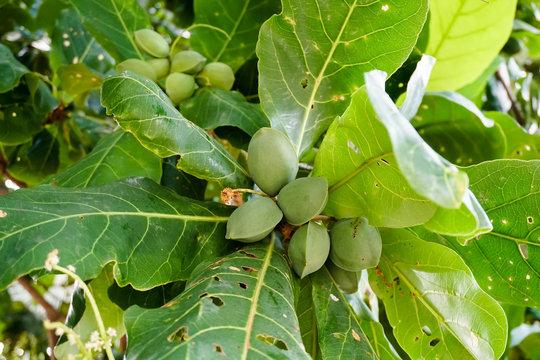Bengal Almond Plant
Terminalia catappa, or Bengal Almond, is a hardy tree growing 10-15m, prefers well-drained loamy soil, full sun, and produces edible nuts with medicinal properties.

Habit
Tree
Height
10-25 m
Growth
Medium
Soil
Well-drained sandy soil
Shade
Full
Moisture
Moderate
Edible
Yes
Medicinal
Yes
Origin
Southeast Asia
Climatic Condition
Tropical
Temperature (°)
25-35°C
Humidity (%)
70-90%
Potting media
Garden soil
Fertilizers
Organic compost
Watering
Regular watering; drought-tolerant once established
Plant Weight
50-100 kg
Flowering Time
Varies
Soil Ph level
5.5 - 7.5
Water Ph level
6.0 - 7.0
Soil EC
0.4 - 0.8
Yield Per Plant
one tree can produce 23-30 kg of nuts
NPK ratio
10:10:10
life Span
Perennial
Health Benefits
Edible seeds; medicinal uses in traditional medicine.
Suggested Grow Media or Potting Mix ?
50% loam, 25% compost, 25% sand
Suggested Fertigation/Fertilizers
Fertilize every 3 months with balanced fertilizer.
Common Diseases and Remedies
Powdery Mildew, Aphids, Leaf Spot, Root Rot, Nut Weevil
White powdery patches on leaves, Curling, yellowing leaves, Brown or black spots on leaves, Yellowing, wilting, Holes in nuts, larvae inside nuts
Apply sulfur-based sprays, Insecticidal soap, neem oil, Prune affected areas, neem oil, Improve soil drainage, avoid overwatering, Remove affected nuts, use beneficial nematodes
Fungicides containing sulfur, Imidacloprid-based insecticides ,Copper-based fungicides, Fungicides with metalaxyl, Insecticides with pyrethroids
HEALTH BENEFITS
· Leaves have anti-inflammatory, antimicrobial, and antioxidant properties
· Used in traditional medicine for liver health and skin conditions

